SDTEST® has 38 different VUCA polls that calculate the 13,643 correlation values between stages of development according to the theory of Spiral Dynamics and answer options of these 38 polls.
We invite curiosity about the systemic mechanisms behind this correlation. There may be hidden variables that provide alternative explanations.
In our analysis of the poll "Where would be your next most exciting opportunity?", we found an intriguing negative correlation that warrants closer examination:
-0.0806 between the In a Startup / Scale up! and the Purple stage.
The critical value of the correlation coefficient for a normal distribution, by William Sealy Gosset (Student) r = 0.0547. This negative correlation of -0.0806 meets the reliability criteria but does not necessarily imply causation.

This negative correlation of -0.0806 between startup/scale-up career preferences and the Purple stage reveals significant misalignment when viewed through the Purple value system lens:
Organizational Perspective:
Organizations operating within the Purple mindset might interpret this correlation as:
- Natural incompatibility between tribal structure and startup unpredictability
- Validation that sacred business traditions clash with startup disruption
- Confirmation that spiritual alignment requires stable, ancestral structures
These organizations prefer:
- Maintaining established hierarchies based on age and tradition
- Operating through ritual-based decision making
- Preserving sacred knowledge over innovation
Team Perspective:
Teams operating from a Purple mindset show resistance because:
- Startups lack established tribal bonds
- Innovation threatens sacred team practices
- Rapid change disrupts ceremonial team dynamics
These teams value:
- Long-standing group relationships
- Traditional mentorship systems
- Predictable ritual-based workflows
Individual Perspective:
Individuals aligned with the Purple value system experience disconnect due to:
- Startup uncertainty threatening tribal security
- Innovation challenging ancestral wisdom
- Modern practices conflicting with spiritual beliefs
They seek:
- Stable environments honoring tradition
- Work guided by spiritual signs
- Organizations respecting ancestral authority
This correlation, viewed through the Purple lens, suggests that those operating at the Purple level may feel disconnected from the startup environment's rapid change and uncertainty. It implies that the Purple value system's focus on tradition, stability, and spiritual connection conflicts with startup culture's emphasis on disruption and innovation.
This correlation shows a fundamental incompatibility between Purple values and startup culture. Purple mindset prioritizes:
- Sacred Knowledge: Startups reject traditional business methods
- Tribal Security: Startups' rapid changes threaten group stability
- Spiritual Signs: Data-driven decisions ignore ancestral guidance
- Sacred Time: Startup speed violates natural rhythms
- Elder Wisdom: Startup youth culture disrespects traditional authority
This correlation demonstrates how Purple value systems fundamentally clash with startup environments, making them naturally unsuitable career choices for Purple-dominant individuals.
Ultimately, this correlation highlights the tension between ancestral wisdom and modern innovation. The aversion to startups might be seen not as resistance to progress, but as protection of sacred traditions and communal bonds in professional life.
In our analysis of the poll "Psychological Wellbeing" (by Carol D. Ryff), we found an intriguing positive correlation that warrants closer examination:
0.0888 between the Positive relations with others. Maintaining close relationships has been difficult and frustrating for me / Strongly agree, and the Red stage.
The critical value of the correlation coefficient for a non-normal distribution, by Spearman r = 0.002. This positive correlation of 0.0888 meets the reliability criteria but does not necessarily imply causation.
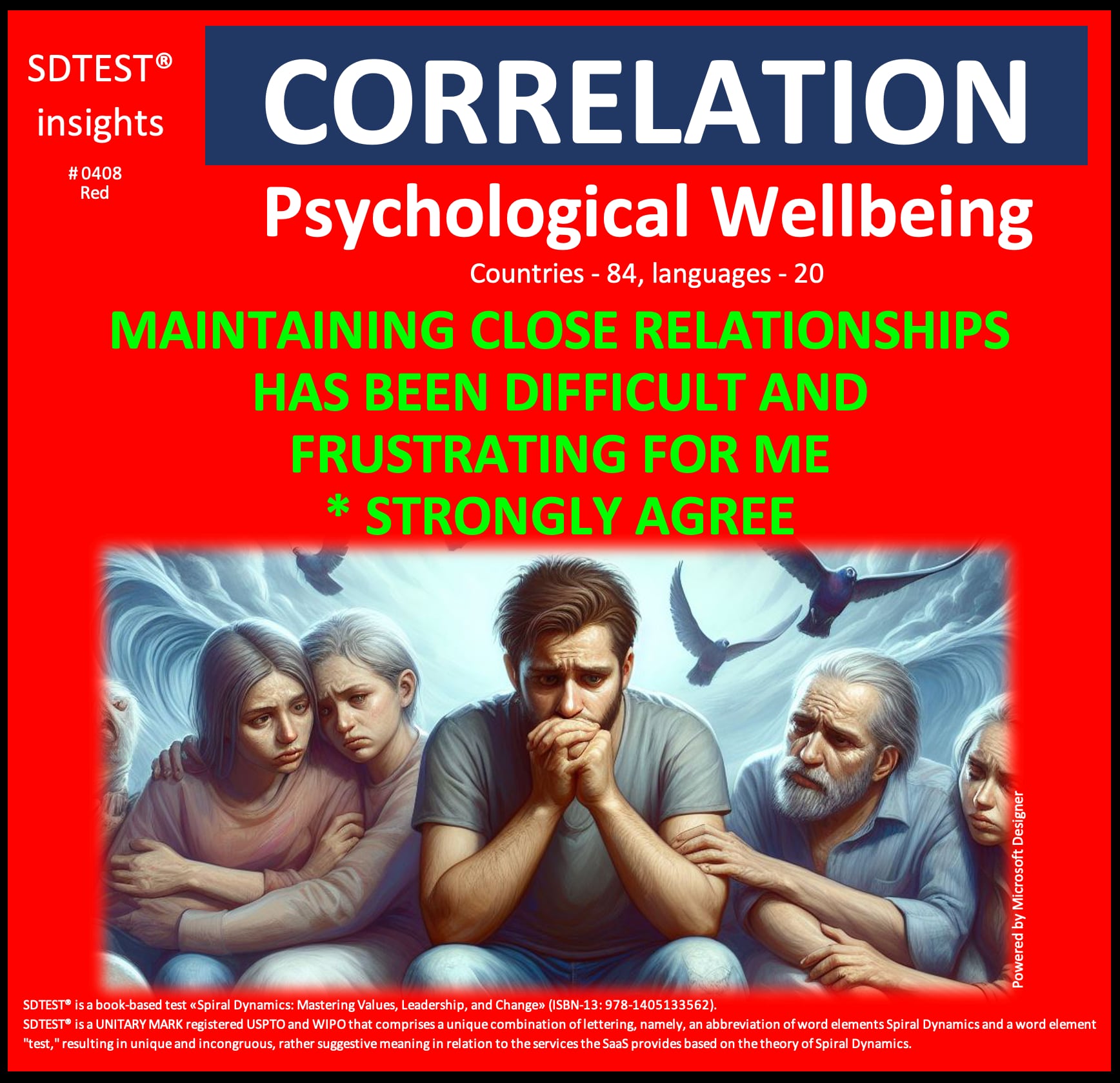
This positive correlation of 0.0888 between strong agreement about relationship difficulties and the Red stage offers revealing insights when viewed through the Red value system lens:
Organizational Perspective:
Organizations operating within the Red mindset might interpret this correlation as:
- Validation of power-based hierarchical structures over relationship building
- Confirmation that dominance-based leadership naturally creates relational friction
- Evidence supporting their belief that competitive advantage matters more than relationships
These organizations might respond by:
- Reinforcing power-based organizational structures
- Rewarding aggressive, competitive behaviors
- Viewing relationship struggles as signs of strong leadership
Team Perspective:
Teams operating from a Red mindset might approach this correlation by:
- Viewing relationship difficulties as natural outcomes of power dynamics
- Interpreting interpersonal friction as proof of strong individual drive
- Seeing relationship challenges as inevitable in competitive environments
These teams might respond by:
- Celebrating competitive victories over collaborative efforts
- Encouraging power plays within team dynamics
- Using relationship tensions to fuel performance
Individual Perspective:
Individuals aligned with the Red value system might interpret this correlation as:
- Personal validation of their dominant, self-focused approach
- Evidence supporting their prioritization of power over connection
- Confirmation that relationship struggles indicate strong individual drive
These individuals might respond by:
- Viewing relationship difficulties as badges of power
- Embracing conflict as a sign of strength
- Using interpersonal challenges to assert dominance
This correlation, viewed through the Red lens, suggests that those operating at the Red level naturally experience relationship difficulties due to their power-focused orientation. It implies that the Red value system's emphasis on dominance, immediate gratification, and self-expression inherently creates interpersonal challenges.
The reasons why strong agreement with relationship difficulties might be characteristic of the Red stage could include:
- Power Focus: Prioritizing dominance over connection
- Immediate Gratification: Lack of patience for relationship building
- Competitive Drive: Viewing relationships as power contests
- Self-Centered Orientation: Difficulty considering others' needs
- Impulsive Behavior: Acting without considering relational impact
This correlation prompts us to consider how power-oriented value systems influence relationship dynamics. It raises questions about the compatibility of strong individual drive with close relationships, particularly in contexts where dominance is prioritized.
Ultimately, this correlation highlights the natural tension between Red value system characteristics and relationship maintenance. Relationship difficulties might be seen not as failures, but as expected outcomes of a power-focused, self-oriented approach to life.
In our analysis of the poll "Ageism in life," we found an intriguing negative correlation that warrants closer examination:
-0.0978 between the Age group 50-54 years and the Blue stage.
The critical value of the correlation coefficient for a normal distribution, by William Sealy Gosset (Student) r = 0.0782. This negative correlation of -0.0978 meets the reliability criteria but does not necessarily imply causation.

This negative correlation of -0.0978 between Ageism experiences in the 50-54 age group and the Blue stage offers meaningful insights when viewed through the lens of the Blue value system:
Organizational Perspective:
Organizations operating within the Blue mindset might interpret this correlation as:
- Validation that traditional social structures naturally respect those in their 50s as pillars of community
- Confirmation that established social norms protect and value mature adults in daily interactions
- Evidence that society's moral frameworks acknowledge the wisdom that comes with life experience
These organizations might respond by:
- Promoting community programs that emphasize respect for mature adults
- Supporting social structures that value traditional family and community roles
- Reinforcing moral teachings about honoring those with life experience
Team Perspective:
Teams operating from a Blue mindset might approach this correlation by:
- Recognizing that people in their 50s often serve as moral anchors in community groups
- Viewing this age group as essential guardians of social traditions and proper conduct
- Acknowledging their natural role in preserving community values and standards
These teams might respond by:
- Engaging 50-54-year-olds as respected voices in community decision-making
- Creating social roles that honor their life experience and moral authority
- Establishing community programs where their wisdom guides younger generations
Individual Perspective:
Individuals aligned with the Blue value system might interpret this correlation as:
- Recognition that their life experience has earned them a respected place in society
- Validation that their role in upholding moral and social order is valued
- Confirmation that their adherence to traditional values protects them from social marginalization
These individuals might respond by:
- Embracing their role as moral guides in family and community life
- Taking pride in their position as bearers of traditional values
- Confidently participating in social institutions where age brings natural authority
This correlation, viewed through the Blue lens, suggests that the 50-54 age group may feel less ageism because they have achieved a naturally respected position in traditional social structures. It implies that the Blue value system's emphasis on moral order, traditional roles, and respect for life experience naturally aligns with reduced age discrimination in daily life.
The reasons why the Age group 50-54 years might not experience Ageism in the Blue stage could include:
- Social Standing: They occupy respected positions in traditional community structures
- Moral Authority: Their life experience gives them natural authority in matters of proper conduct
- Family Role: They often serve as heads of extended families or community groups
- Traditional Value: Their age group is naturally respected in traditional social frameworks
- Cultural Position: They help maintain and transmit important social and cultural values
This correlation prompts us to consider how traditional value systems naturally elevate those who embody established moral and social principles. It raises important questions about how traditional social structures and respect for life experience create environments where ageism is less prevalent in daily life.
Ultimately, this correlation highlights how Blue value systems, with their emphasis on moral order, traditional roles, and proper social conduct, may naturally protect against ageism for those who have accumulated sufficient life experience to be seen as legitimate bearers of social and moral tradition.
In our analysis of the poll "Why do people procrastinate?" we found an intriguing negative correlation that warrants closer examination:
-0.0964 between the Plate Too Full: Having too many tasks or responsibilities, leaving little time or energy for specific tasks / Strongly Applicable and the Orange stage.
The critical value of the correlation coefficient for a normal distribution, by William Sealy Gosset (Student) r = 0.0684. This negative correlation of -0.0964 meets the reliability criteria but does not necessarily imply causation.
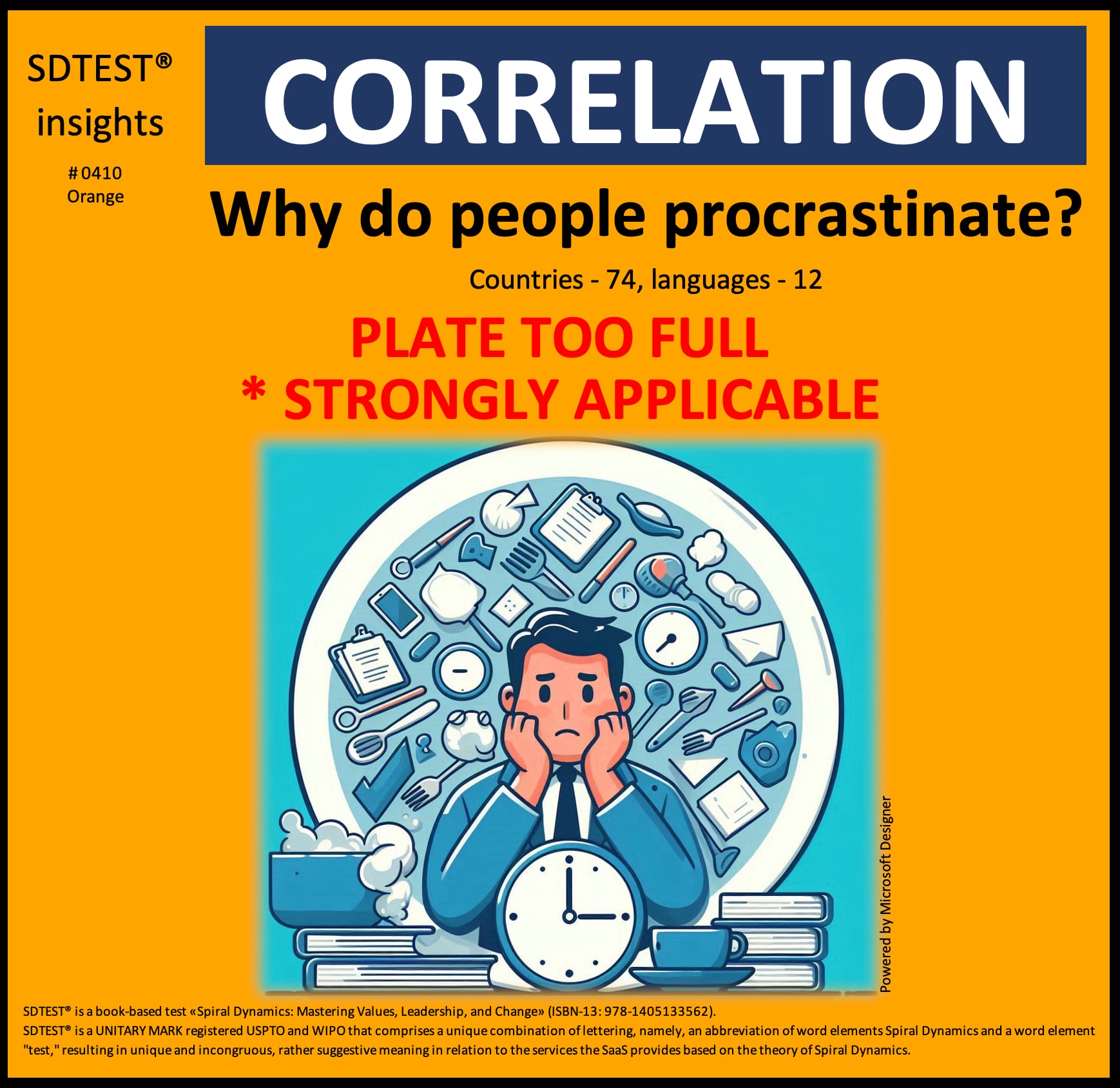
This negative correlation of -0.0964 between "Plate Too Full" as a reason for procrastination and the Orange stage offers meaningful insights when viewed through the lens of the Orange value system:
Organizational Perspective:
Organizations operating within the Orange mindset might interpret this correlation as:
- Validation that efficient systems and rational processes eliminate the "too full plate" excuse
- Confirmation that data-driven workload management prevents task overload
- Evidence that scientific approaches to productivity optimize resource allocation
These organizations might respond by:
- Implementing advanced project management tools and analytics
- Developing AI-driven task prioritization systems
- Creating metrics-based performance optimization frameworks
Team Perspective:
Teams operating from an Orange mindset might approach this correlation by:
- Viewing it as proof that logical task distribution prevents overload
- Interpreting it as validation of efficiency-driven workflow management
- Seeing it as evidence that scientific approaches to time management work
These teams might respond by:
- Adopting sophisticated productivity tracking software
- Implementing data-driven sprint planning methodologies
- Using analytics to optimize task allocation and deadlines
Individual Perspective:
Individuals aligned with the Orange value system might interpret this correlation as:
- Personal validation of their strategic approach to time management
- Evidence supporting their belief in technological solutions to workload challenges
- Confirmation that rational planning prevents task overflow
These individuals might respond by:
- Leveraging productivity apps and digital tools
- Applying scientific methods to personal time management
- Using data analytics to optimize their daily schedules
This correlation, viewed through the Orange lens, suggests that those operating at the Orange level may be less likely to experience overwhelming workloads due to their rational, systematic approach to task management. It implies that the Orange value system's emphasis on efficiency, technology, and scientific methods naturally prevents the "plate too full" syndrome.
The reasons why "Plate Too Full" might not be seen as a cause for procrastination in the Orange stage could include:
- Efficiency Focus: Orange-level thinking optimizes workflows to prevent overload
- Technology Utilization: Advanced tools help manage and prioritize tasks effectively
- Data-Driven Decisions: Analytics guide resource allocation and time management
- Strategic Planning: Scientific approaches to scheduling prevent task accumulation
- Performance Optimization: Systematic monitoring prevents workload issues before they arise
This correlation prompts us to consider how achievement-oriented value systems approach workload management. It raises questions about the effectiveness of technological and scientific approaches to preventing task overflow and subsequent procrastination.
Ultimately, this correlation highlights how Orange value systems, with their emphasis on efficiency, technology, and scientific management, may naturally protect against the "too full plate" syndrome through systematic optimization of time and resources.
In our analysis of the poll "Oxford Happiness Survey," we found an intriguing positive correlation that warrants closer examination:
0.0747 between the I am intensely interested in other people / Strongly Agree and the Green stage.
The critical value of the correlation coefficient for a normal distribution, by William Sealy Gosset (Student) r = 0.0523. This positive correlation of 0.0747 meets the reliability criteria but does not necessarily imply causation.
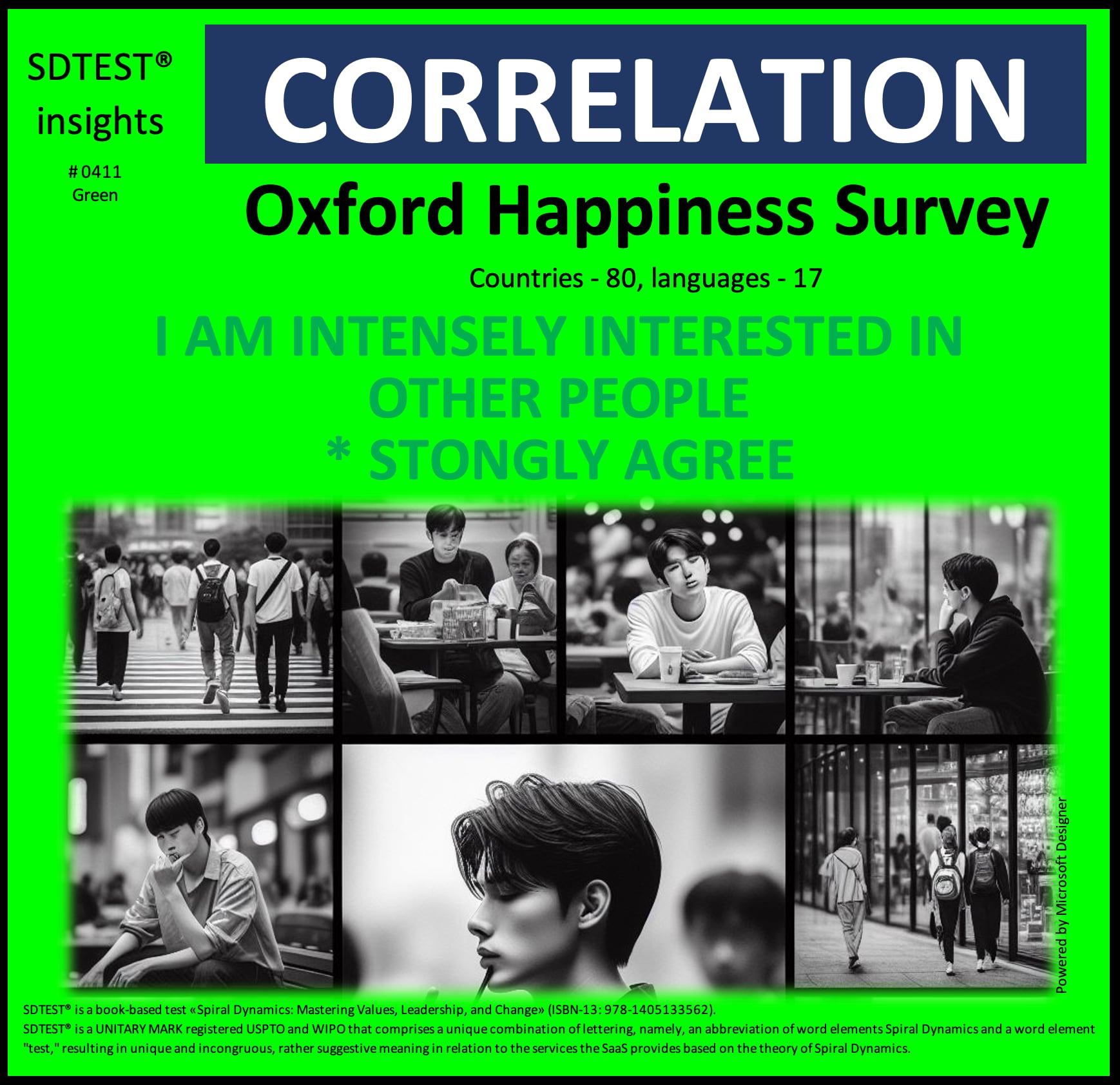
This positive correlation of 0.0747 between being "intensely interested in other people" and the Green stage offers meaningful insights when viewed through the lens of the Green value system:
Organizational Perspective:
Organizations operating within the Green mindset might interpret this correlation as:
- Validation of their human-centered, inclusive approach to organizational culture
- Confirmation that prioritizing relationships and human connection drives collective growth
- Evidence that fostering genuine interest in diverse perspectives strengthens organizational fabric
These organizations might respond by:
- Creating more spaces for authentic dialogue and story sharing
- Implementing policies that prioritize human connection over hierarchical efficiency
- Developing programs that celebrate individual uniqueness while fostering community
Team Perspective:
Teams operating from a Green mindset might approach this correlation by:
- Viewing it as affirmation of their focus on deep interpersonal connections
- Interpreting it as validation of their emphasis on emotional intelligence and empathy
- Seeing it as proof that authentic human interest creates stronger collaborative environments
These teams might respond by:
- Dedicating time for personal sharing and relationship building
- Creating safe spaces for vulnerable and authentic communication
- Fostering cross-cultural understanding and appreciation
Individual Perspective:
Individuals aligned with the Green value system might interpret this correlation as:
- Personal validation of their commitment to understanding others' lived experiences
- Evidence supporting their belief in the transformative power of human connection
- Confirmation that genuine interest in others contributes to collective well-being
These individuals might respond by:
- Actively seeking out diverse perspectives and life stories
- Deepening their practice of empathetic listening
- Engaging in activities that broaden their understanding of different cultures
This correlation, viewed through the Green lens, suggests that those operating at the Green level naturally develop deep interest in others as part of their holistic worldview. It implies that the Green value system's emphasis on connection, understanding, and inclusivity naturally fosters genuine curiosity about other people's lives and experiences.
The reasons why people might be intensely interested in others in the Green stage could include:
- Holistic Worldview: Recognition that all human experiences are interconnected
- Empathetic Development: Natural evolution of emotional intelligence and compassion
- Cultural Appreciation: Genuine curiosity about diverse perspectives and ways of being
- Social Justice: Understanding others' experiences as crucial for creating equitable systems
- Collective Growth: Belief that learning from others enriches the whole community
This correlation prompts us to consider how value systems that prioritize human connection and understanding naturally foster genuine interest in others. It raises important questions about the role of interpersonal curiosity in building more inclusive and sustainable communities.
Ultimately, this correlation highlights how Green value systems, with their emphasis on relationships, diversity, and collective well-being, may naturally cultivate deep interest in others as a pathway to creating more harmonious and interconnected communities.
-0.0899 between the Staff reductions and the Yellow stage.
The critical value of the correlation coefficient for a normal distribution, by William Sealy Gosset (Student) r = 0.0853. This negative correlation of -0.0899 meets the reliability criteria but does not necessarily imply causation.
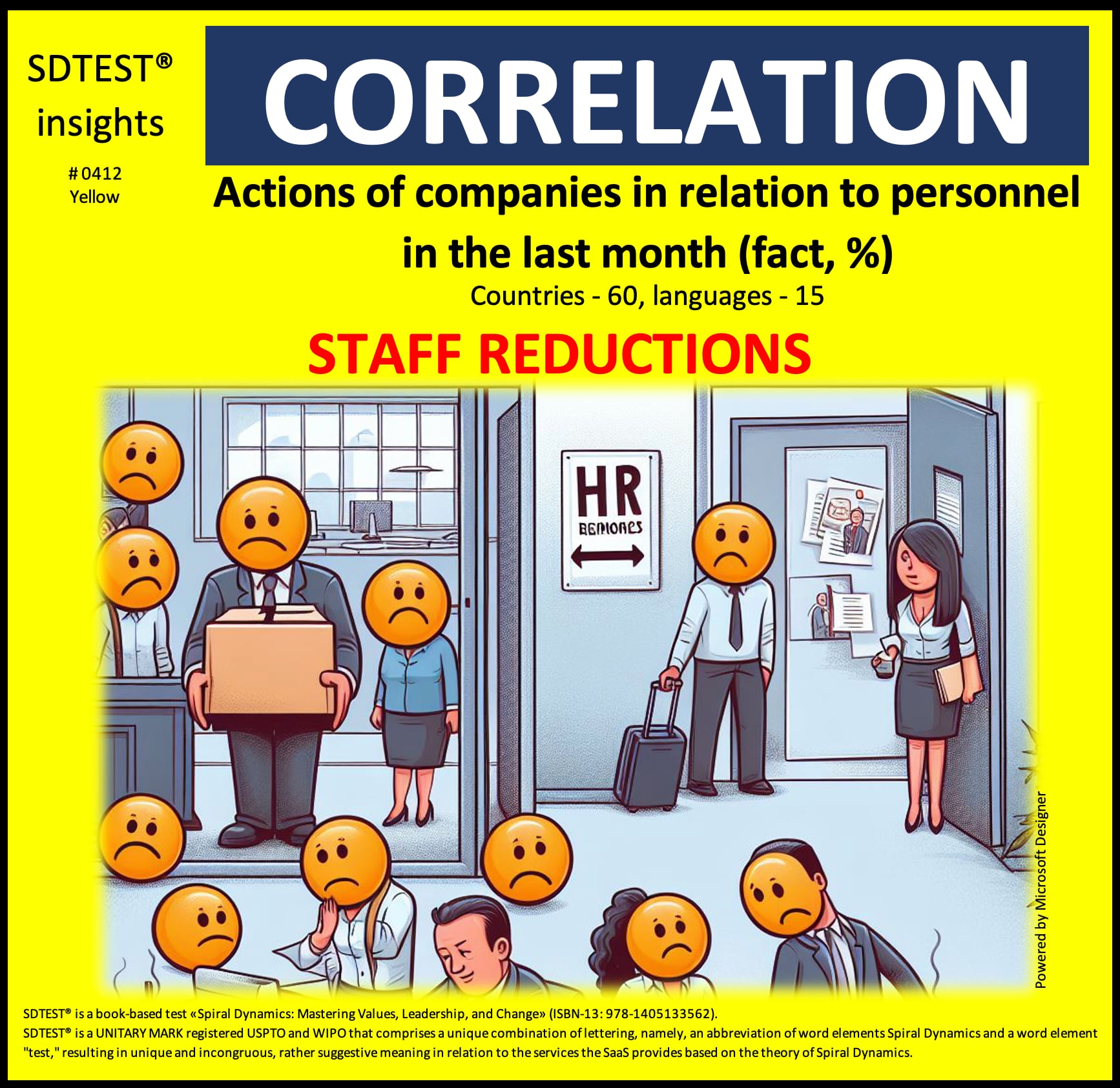
This negative correlation of -0.0899 between staff reductions and the Yellow stage offers meaningful insights when viewed through the lens of the Yellow value system:
Organizational Perspective:
Organizations operating within the Yellow mindset might interpret this correlation as:
- Validation of their systemic understanding that human capital is adaptable and multifaceted
- Confirmation that workforce challenges require innovative, rather than reductive solutions
- Evidence that sustainable organizational success depends on evolving with complexity rather than simplifying through reduction
These organizations might respond by:
- Implementing flexible role structures that allow talent to flow where needed
- Creating adaptive systems that transform roles rather than eliminate them
- Developing innovative approaches to workforce evolution that preserve organizational knowledge
Team Perspective:
Teams operating from a Yellow mindset might approach this correlation by:
- Viewing it as confirmation that adaptive team structures outperform traditional fixed models
- Interpreting it as validation of their fluid approach to roles and responsibilities
- Seeing it as evidence that integrated team systems naturally find equilibrium without reduction
These teams might respond by:
- Adopting dynamic role allocation based on emerging needs
- Creating self-organizing structures that optimize human potential
- Developing new ways to redistribute work during challenging periods
Individual Perspective:
Individuals aligned with the Yellow value system might interpret this correlation as:
- Personal validation of their ability to adapt and evolve within complex systems
- Evidence supporting their understanding of organizational dynamics
- Confirmation that personal growth and adaptability ensure sustainable value
These individuals might respond by:
- Continuously evolving their skill sets to meet emerging needs
- Embracing fluid role definitions and responsibilities
- Finding innovative ways to create value in changing circumstances
This correlation, viewed through the Yellow lens, suggests that those operating at the Yellow level may naturally find alternatives to staff reduction by understanding and working with organizational complexity. It implies that the Yellow value system's emphasis on integration, adaptation, and systemic thinking naturally leads to more sustainable workforce solutions.
The reasons why companies might not resort to staff reductions in the Yellow stage could include:
- Systems Understanding: Recognition that staff reductions often create unforeseen systemic complications
- Adaptive Capacity: Ability to transform roles and responsibilities rather than eliminate them
- Innovation Focus: Preference for creative solutions over reductive measures
- Value Integration: Understanding of how to optimize existing human capital in new ways
- Complexity Navigation: Skill at finding balanced solutions that preserve organizational knowledge
This correlation prompts us to consider how more evolved value systems approach workforce challenges. It raises important questions about the relationship between organizational complexity and sustainable human resource management.
Ultimately, this correlation highlights how Yellow value systems, with their emphasis on integration, adaptation, and systemic thinking, may naturally lead organizations to find more sophisticated alternatives to staff reduction, creating more resilient and sustainable organizational models.
In our analysis of the poll "Empathy is," we found an intriguing positive correlation that warrants closer examination:
0.1285 between the Really listening to what others have to say / Strongly Agree and the Turquoise stage.
The critical value of the correlation coefficient for a normal distribution, by William Sealy Gosset (Student) r = 0.0653. This positive correlation of 0.1285 meets the reliability criteria but does not necessarily imply causation.
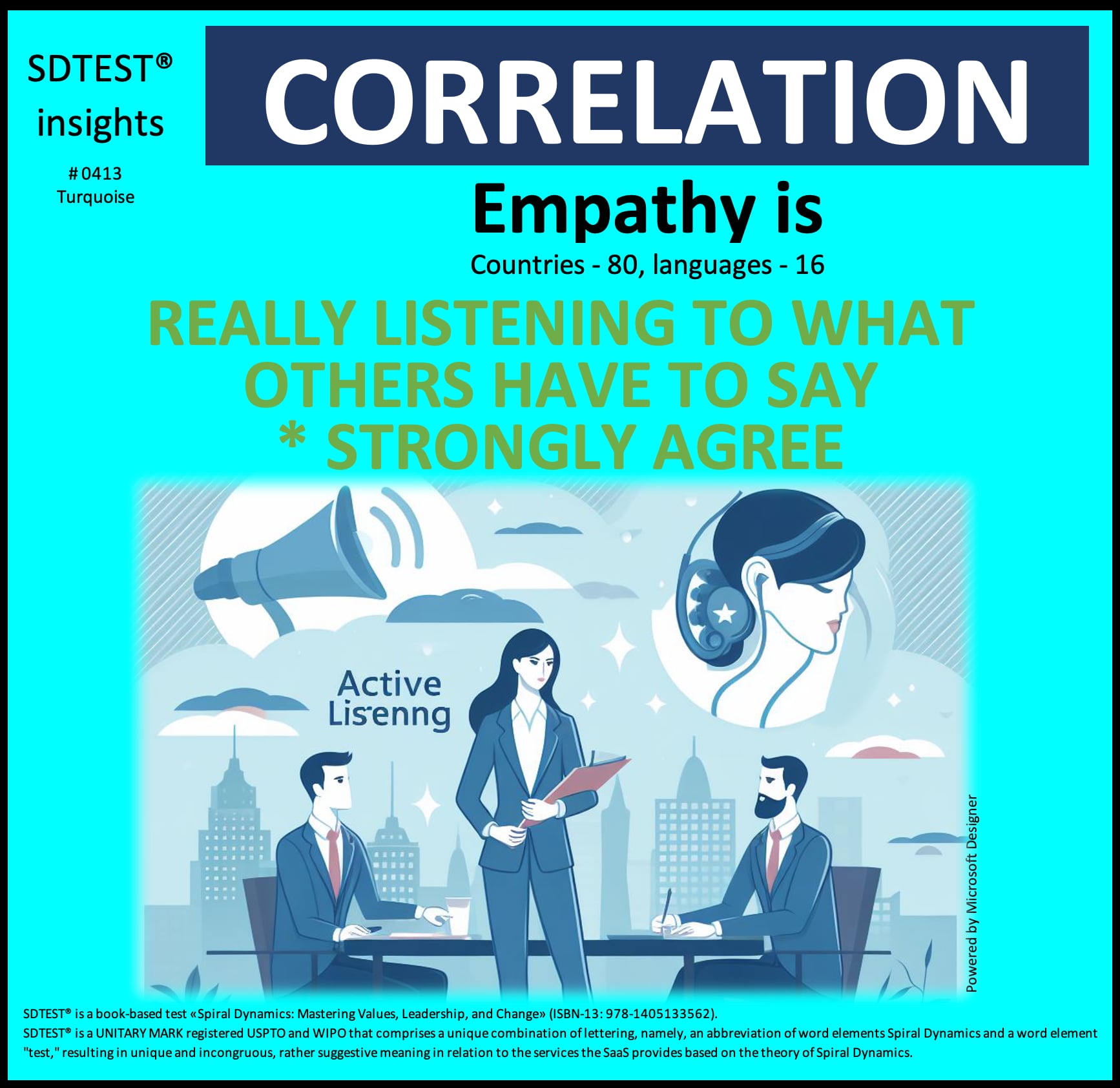
This positive correlation of 0.1285 between strongly agreeing that "Empathy is really listening" and the Turquoise stage offers meaningful insights when viewed through the lens of the Turquoise value system:
Organizational Perspective:
Organizations operating within the Turquoise mindset might interpret this correlation as:
- Validation that deep listening creates essential interconnections within the larger ecosystem
- Confirmation that authentic hearing transcends mere communication to foster universal understanding
- Evidence that listening is a fundamental force in creating harmonious living systems
These organizations might respond by:
- Creating spaces that honor the sacred nature of human communication
- Developing practices that integrate deep listening into all aspects of organizational life
- Fostering environments where listening becomes a path to universal consciousness
Team Perspective:
Teams operating from a Turquoise mindset might approach this correlation by:
- Viewing it as confirmation that listening is key to sensing the collective field
- Interpreting it as validation of their focus on emergent group wisdom
- Seeing it as evidence that deep listening connects teams to universal patterns
These teams might respond by:
- Practicing collective listening as a way to access higher consciousness
- Creating sacred spaces for deep, transformative dialogue
- Developing listening practices that honor both spoken and unspoken wisdom
Individual Perspective:
Individuals aligned with the Turquoise value system might interpret this correlation as:
- Personal validation of their role as conscious listeners in the universal web
- Evidence supporting their understanding of listening as a spiritual practice
- Confirmation that deep listening connects individual consciousness to the collective field
These individuals might respond by:
- Deepening their listening practice as a path to universal awareness
- Embracing listening as a way to honor the sacred in others
- Using listening as a tool for accessing collective wisdom
This correlation, viewed through the Turquoise lens, suggests that those operating at the Turquoise level naturally understand listening as a profound gateway to universal consciousness and interconnection. It implies that the Turquoise value system's emphasis on holistic awareness and cosmic unity naturally aligns with deep, transformative listening practices.
The reasons why people might strongly agree that empathy is really listening in the Turquoise stage could include:
- Universal Connection: Recognition that listening connects us to the cosmic web of consciousness
- Sacred Awareness: Understanding listening as a spiritual practice that honors universal wisdom
- Collective Field: Sensing how listening creates access to group consciousness
- Natural Harmony: Aligning with the natural flow of universal energy through deep listening
- Transformative Power: Experiencing how genuine listening facilitates the evolution of consciousness
This correlation prompts us to consider how evolved value systems understand the profound role of listening in human consciousness. It raises important questions about the relationship between listening, empathy, and universal awareness.
Ultimately, this correlation highlights how Turquoise value systems, with their emphasis on universal connection, spiritual awareness, and collective consciousness, may naturally recognize deep listening as a fundamental path to empathetic understanding and cosmic harmony.
What insights do you gain from today's correlation? How might we study this relationship more carefully before deducing causation?
We welcome respectful and wise perspectives! Stay tuned every week as we share more results and insights.
After login or registration, free access to the poll results in the FAQ section.
2025.02.16
FearpersonqualitiesprojectorganizationalstructureRACIresponsibilitymatrixCritical ChainProject Managementfocus factorJiraempathyleadersbossGermanyChinaPolicyUkraineRussiawarvolatilityuncertaintycomplexityambiguityVUCArelocatejobproblemcountryreasongive upobjectivekeyresultmathematicalpsychologyMBTIHR metricsstandardDEIcorrelationriskscoringmodelGame TheoryPrisoner's Dilemma
ویلری کوسنکو
پروڈکٹ کا مالک SaaS SDTEST®
ویلیری 1993 میں ایک سماجی ماہر نفسیات کے طور پر اہل ہوئے تھے اور اس کے بعد سے وہ پروجیکٹ مینجمنٹ میں اپنے علم کا اطلاق کرتے ہیں۔
ویلری نے 2013 میں ماسٹر کی ڈگری اور پروجیکٹ اور پروگرام مینیجر کی اہلیت حاصل کی۔ اپنے ماسٹرز پروگرام کے دوران، وہ پروجیکٹ روڈ میپ (GPM Deutsche Gesellschaft für Projektmanagement e. V.) اور Spiral Dynamics سے واقف ہوئے۔
ویلیری V.U.C.A کی غیر یقینی صورتحال کو تلاش کرنے کے مصنف ہیں۔ نفسیات میں اسپائرل ڈائنامکس اور ریاضی کے اعدادوشمار کا استعمال کرتے ہوئے تصور، اور 38 بین الاقوامی پول۔








